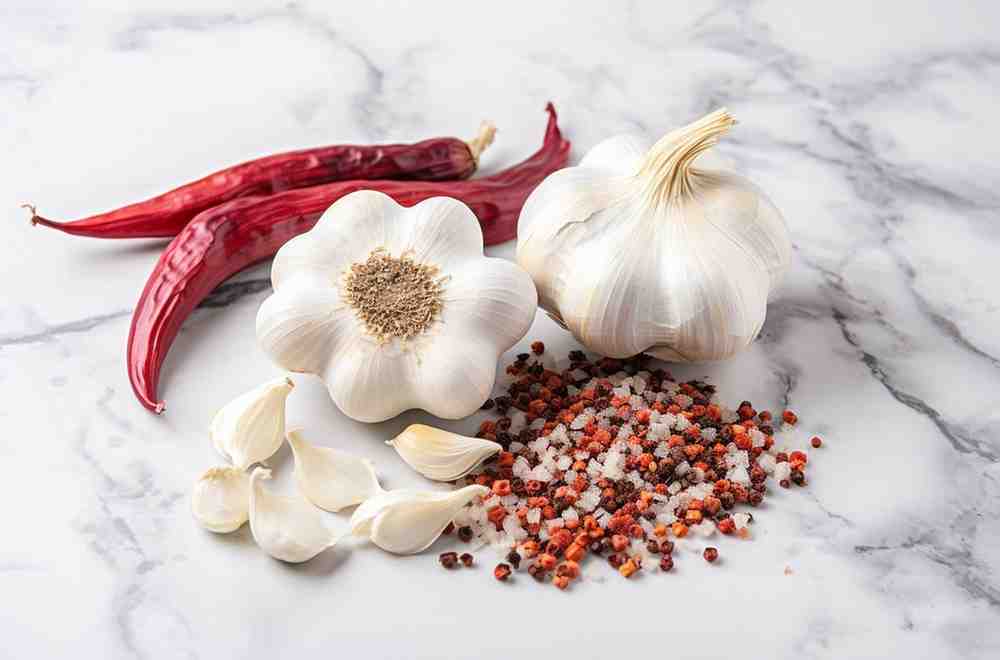Adobo is a versatile and widely loved seasoning blend originating in Latin America and the Philippines, known for its bold flavor and ability to enhance a variety of dishes. The blend typically includes garlic, oregano, and paprika and is often used as a marinade or dry rub, adding depth to meats, seafood, and vegetables.
- Broad Appeal: Adobo’s robust taste and adaptability have made it a staple in many kitchens, particularly in Mexican, Puerto Rican, and Filipino cuisines.
- Core Ingredient: Adobo imparts an earthy, slightly smoky flavor that serves as a base in dishes across Latin America, highlighting the region’s culinary richness.
While both Latin American and Filipino versions of adobo share a name, their differences reflect the unique cultural heritage of each region.
Origins and History of Adobo in Latin America and the Philippines
Adobo’s history is deeply rooted in Spanish colonization. The word “adobo” comes from the Spanish verb “adobar,” which means “to marinate” or “to preserve.” Spanish colonists introduced the concept to Latin America and the Philippines, where it evolved into distinct versions based on local ingredients and cooking techniques.
The Influence of Spanish Colonization
Here’s how adobo became a staple in both Latin America and the Philippines:
- Spanish Origins: Adobo originated as a preservation method in Spain, where meats were marinated in vinegar, garlic, and spices to prolong freshness. Spanish colonists brought this technique to their colonies, where it adapted to local tastes and ingredients.
- Development in Latin America: In Latin America, the blend evolved to incorporate ingredients such as oregano, cumin, and sometimes chili powder. This mix became known as a dry spice blend, used primarily to season meats before grilling or slow-cooking.
- Adaptation in the Philippines: In the Philippines, adobo became known as a method of cooking rather than just a seasoning. Filipino adobo often involves marinating meats in soy sauce, vinegar, garlic, and bay leaves before braising, creating a tangy and savory dish distinct from the Latin American version.
Regional Differences in Adobo
The variations of adobo across regions highlight the culinary diversity within Latin America and the Philippines:

- Latin American Adobo:
- In Latin America, adobo typically refers to a dry spice mix. Mexican adobo, for example, often includes a blend of garlic, oregano, paprika, and cumin, sometimes with added chili powder for heat. This seasoning is commonly used as a rub for meats, adding warmth and spice without overpowering the dish.
- In Puerto Rico, adobo includes dried coriander seeds and cumin, bringing a slightly different, more aromatic profile to the blend.
- Filipino Adobo:
- Filipino adobo refers to a cooking method rather than a specific blend. The marinade includes soy sauce, vinegar, garlic, and bay leaves, creating a savory, tangy flavor distinct from the Latin American dry rub. Filipino adobo is often made with chicken or pork and simmered until tender.

Key Ingredients in Adobo and Their Flavor Profiles
Adobo’s blend of spices creates a complex flavor profile that enhances a range of dishes. While ingredients can vary by region, several core spices define the adobo taste, each adding a unique dimension.
Essential Ingredients in Latin American Adobo
Here are the main spices commonly found in Latin American adobo:
- Garlic:
- Garlic provides a pungent, savory flavor that balances the other spices in adobo. Its robust taste is essential to the blend, enhancing the depth and complexity of the seasoning.
- Oregano:
- This herb brings a slightly minty, earthy taste to adobo, giving it a Mediterranean influence. Oregano’s mild bitterness complements the warmth of garlic and paprika, adding balance.
- Paprika:
- Paprika contributes a mild sweetness and vibrant red color. This spice also has a subtle smokiness, which adds depth to the blend and enhances the flavor of grilled or roasted dishes.
These core spices create the signature taste of adobo, lending warmth, earthiness, and a touch of smoke.
Additional Ingredients for Flavor Variation
Different regions and families often add other spices to customize their adobo blend. Here are some common additions:
- Vinegar:
- Vinegar, frequently added to adobo marinades, adds tanginess and helps tenderize meat. While not always part of the dry blend, it’s essential in wet adobo marinades, particularly in Puerto Rican and Filipino cooking.
- Black Pepper and Cumin:
- These spices add warmth and complexity. Black pepper brings a mild heat, while cumin adds a smoky, earthy undertone that pairs well with the core ingredients, especially in Mexican adobo.
- Chili Powder:
- Some Latin American variations, especially Mexican, add chili powder for a spicy kick. This addition is common in regions where spicy foods are popular, allowing for a bolder, hotter version of adobo.
These additional ingredients provide flexibility, allowing cooks to adjust the adobo blend to suit different recipes and taste preferences.
Differences Between Adobo Spice Mix and Adobo Marinade
Adobo can be used as both a dry spice mix and a wet marinade, each form lending different flavors and textures to dishes.
- Adobo Spice Mix:
- This dry blend typically includes garlic powder, oregano, paprika, and sometimes cumin or black pepper. It’s ideal for rubbing directly onto meats, creating a flavorful crust when grilled, baked, or fried.
- Adobo Marinade:
- The marinade version usually combines vinegar, oil, and adobo spices, allowing for deeper penetration into the meat. Marinating meat in adobo helps tenderize it and enhances the flavor profile. Wet adobo marinades are popular in Puerto Rican and Filipino dishes.
Both versions offer unique benefits, allowing cooks to use adobo in various ways depending on the dish.
Culinary Applications of Adobo Seasoning
Adobo seasoning’s bold and savory flavors enhance many traditional Latin American dishes. The blend’s versatility makes it an excellent choice for meats, seafood, vegetables, and more. Let’s explore some popular and creative ways to use adobo in your kitchen.
Traditional Latin American Dishes Using Adobo
Adobo seasoning features prominently in several Latin American recipes, adding rich, earthy flavors that define these dishes:
- Grilled and Marinated Meats:
- In many Latin American kitchens, adobo serves as a marinade or rub for meats like chicken, pork, and beef. The spices penetrate deeply, giving the meat a complex, robust flavor when grilled or roasted.
- Adobo de Puerco (Mexican Pork Stew):
- This traditional Mexican dish simmers pork in an adobo sauce, combining the seasoning blend with tomatoes, vinegar, and chili for a hearty, savory stew.
- Vegetable and Bean Dishes:
- Adobo also enhances vegetarian dishes. Roasted vegetables, beans, and even tofu gain depth and warmth when seasoned with adobo, making them more satisfying and flavorful.
These traditional uses show how adobo’s versatility brings out the best in a range of ingredients, from meat to vegetables.
Modern and Creative Uses for Adobo
Adobo’s flavor extends well beyond traditional recipes, making it a great addition to contemporary and fusion cooking. Here are a few innovative ways to incorporate adobo:
- Roasted Vegetables: Toss vegetables like bell peppers, potatoes, and zucchini with adobo before roasting. The spices add warmth and a slight smokiness, elevating simple vegetable dishes.
- Snack Seasoning: Sprinkle adobo over popcorn or roasted nuts for a quick, flavorful snack with a Latin twist. The spice blend provides a savory kick that pairs well with salty treats.
- Marinades and Rubs for Grilled Seafood: Use adobo in marinades for shrimp or fish, combining it with olive oil and lime juice. The seasoning enhances the natural flavors of seafood, giving it a hint of earthiness and spice.
- Salad Dressings and Sauces: Mix adobo with vinegar or lime juice and olive oil for a zesty, flavorful dressing. This blend works well on grain bowls or salads, adding depth and character to lighter meals.
These modern applications showcase adobo’s adaptability, allowing you to experiment with it in a variety of dishes.
Health Benefits of Adobo Seasoning
Adobo seasoning not only adds flavor but also offers several health benefits. Its primary ingredients—garlic, oregano, and paprika—contain beneficial compounds that support wellness.
Key Health Benefits of Adobo Seasoning Ingredients
Each spice in adobo brings unique nutritional properties, making this blend a functional addition to meals:
- Garlic:
- Known for immune-boosting properties, garlic contains allicin, a compound that supports cardiovascular health and helps fight infections. Regular consumption of garlic may also help lower blood pressure.
- Oregano:
- Oregano is rich in antioxidants, particularly rosmarinic acid, which helps protect cells from damage. The herb also provides antimicrobial benefits, supporting gut and immune health.
- Paprika:
- Paprika contains vitamins A, E, and C, which are essential for immune function, eye health, and skin health. Additionally, the carotenoids in paprika have antioxidant effects that may reduce inflammation.
These ingredients contribute to a flavorful seasoning that also supports health, making adobo a beneficial choice in daily cooking.
Incorporating Adobo into a Balanced Diet
Incorporating adobo into balanced meals is easy. Pairing it with lean proteins, whole grains, and fresh vegetables provides a well-rounded, nutrient-rich diet. Adobo’s rich flavors can also help reduce the need for added salt or fats, enhancing the taste of food naturally.
FAQs About Adobo Seasoning
Adobo seasoning is widely popular, but it often raises questions for those new to this spice blend. Here are answers to some frequently asked questions:
What ingredients are in traditional adobo seasoning?
- Traditional Latin American adobo usually contains garlic, oregano, and paprika, along with optional spices like cumin, black pepper, and vinegar in marinades.
How is adobo seasoning used in cooking?
- Adobo is versatile and can be used as a dry rub for meats, a marinade base, or a seasoning for vegetables, beans, and stews.
What’s the difference between Filipino and Latin American adobo?
- Filipino adobo refers to a cooking style that involves marinating and simmering meats in vinegar, soy sauce, and spices, while Latin American adobo is primarily a dry seasoning blend used for marinating or seasoning.
Can you make adobo seasoning at home?
- Yes, adobo is easy to make at home. Combining garlic powder, oregano, paprika, and optional spices like cumin and black pepper allows you to create a custom blend.
Is adobo seasoning spicy?
- Adobo is generally mild, though some versions include chili powder or pepper for a hint of heat. The spice level can be adjusted to taste.
These FAQs provide helpful insights for understanding and using adobo seasoning, whether in traditional or modern dishes.
Tips for Making and Using Adobo Seasoning at Home
To enjoy the best flavors from adobo, here are some tips for making and using it effectively:
- Choose Fresh Ingredients: Fresh garlic, high-quality oregano, and smoked paprika offer the most vibrant flavor. When making adobo from scratch, start with fresh spices for the best results.
- Store Properly: Keep adobo in an airtight container in a cool, dark place to preserve its flavor. When stored correctly, adobo seasoning can last up to six months.
- Adjust to Taste: Customize adobo to suit your preferences by adding chili powder for heat or cumin for a smoky undertone. Adjusting the blend allows for a unique flavor tailored to specific dishes.
- Use as a Marinade: For the best flavor, marinate meats in adobo for at least an hour before cooking. The seasoning penetrates the meat, adding depth and enhancing tenderness.
Following these tips will help you maximize adobo’s flavor, allowing it to shine in both traditional and creative recipes.

